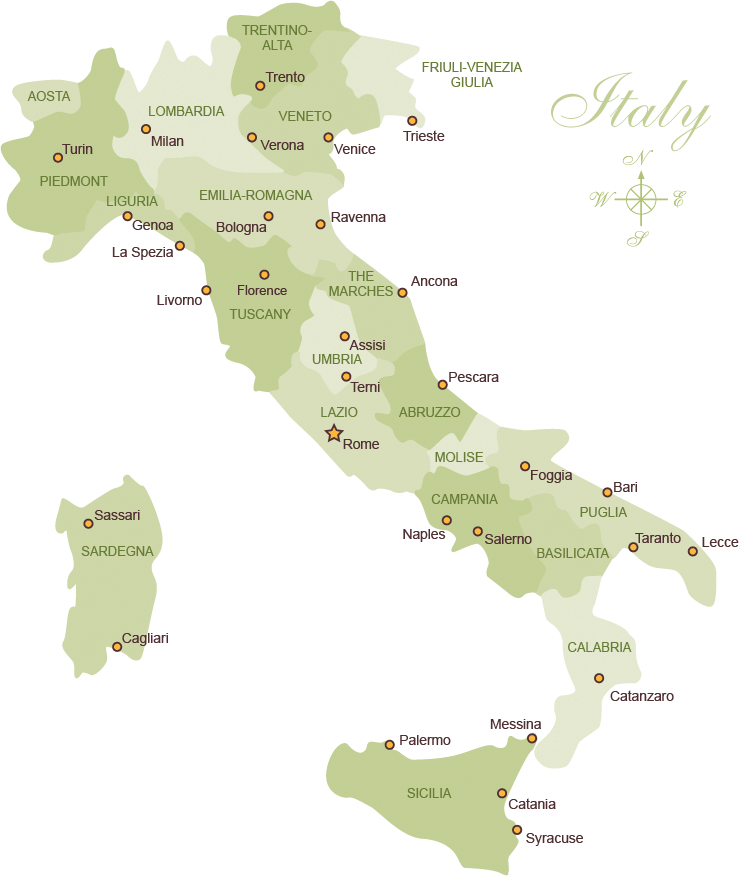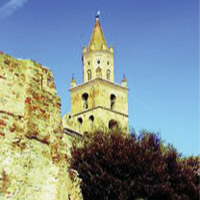

Abruzzo
A region of central Italy, Abruzzo is largely mountainous, and one third of the region is designated as national or regional park. The Apennine mountain chain runs through the Abruzzo and its high points are the Gran Sasso and Maiella Massif, home to luxurious ski resorts. The region is rich in natural beauties and history, but is only just starting to be discovered by tourists. Abruzzo’s wealth of castles and medieval towns set against the backdrop of untouched natural beauty make it the perfect vacation destination.
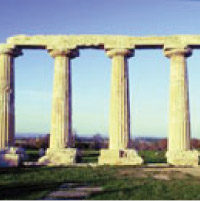

Basilicata
Located in the south of Italy, the Basilicata region boasts a mountainous interior with coastlines on both the Tyrrhenian Sea and the Ionian Sea. It is a land shrouded in mystery, with magical rituals of pagan origin that are sure to fascinate the curious traveler. Here you’ll find archeological digs, medieval towns, Romanesque churches, Renaissance frescoes and gourmet cuisine, along with unparalleled natural wilderness, that you cannot find nowhere else on earth.
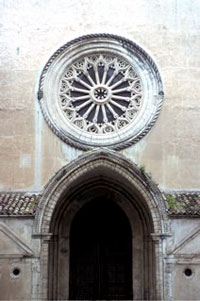

Calabria
One of Italy’s oldest regions, Calabria is located in southern Italy and occupies the “toe” of the Italian peninsula, south of Naples. Also largely mountainous, travelers will find scores of tiny villages and medieval castles nestled on the rugged slopes of the Calabria’s mountains, while the coastlines feature landscapes of wild beauty. Though the official language of Calabria is Italian, as a result of thousands of years of foreign occupation, other historical languages have been spoken in this region for centuries.
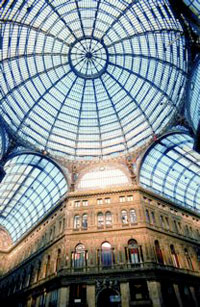

Campania
Campania features some of the most popular destinations in all of Italy. Featuring an interior of rugged terrain and a coastline that dazzles visitors with its spectacular beauty, this region boasts the Amalfi Coast, a 30-mile stretch of land south of Naples, the region’s capital, that includes the tiny cliff-hanging towns of Positano and Ravello, and the famous Sorrento. Just a short ferry ride across the Bay of Naples lie the enchanting islands of Ischia and Capri. Campania is extraordinarily rich in ancient Roman ruins, which can be found at Herculaneum, Pompeii, and Paestum. Amphitheaters, triumphal arches, villas are numerous and remarkable. One could easily spend a lifetime basking in the yellow sunshine and clear blue waters of this breathtaking region in the South of Italy.
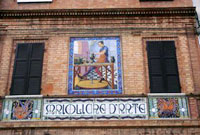

Emilia-Romagna
If one goes to Florence, Venice, or Rome to sightsee, then one visits Emilia-Romagna to eat. One of Italy’s wealthiest regions, it is home to the fertile plains of the Po River Valley, and produces much of the country’s wheat and dairy products. A traveler surely cannot miss such cities as Bologna, home to some of the finest culinary traditions in Italy; Ravenna, famous for its spectacular mosaics from the Byzantine empire; and the charming Parma, its claims to fame of course being parmigiano cheese and proscuitto (Parma ham). For the food lover, the culinary tradition of Emilia-Romagna won’t fail to impress.
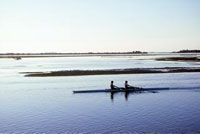

Friuli-Venezia Giulia
This region seems to receive less than its deserving share of recognition. Located in Italy’s northeastern corner, it is barely mentioned in most travel guides and rarely visited, which makes it an ideal location for travelers seeking an “off the beaten path” destination. One of Italy’s most versatile regions, it features something for everyone: from snow-capped mountains, to sandy beaches, Roman ruins, and picturesque fishing villages. The inspiration to prominent literary figures including James Joyce and Ernest Hemingway, Friuli-Venezia Giulia is sure to satisfy the tastes of any curious traveler.
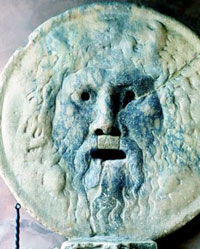

Rome/Lazio
Lazio is a region of central Italy. Home to the Italian capital of Rome, it welcomes travelers to immerse themselves in the ancient world. A walk through the streets of Rome is like stepping back in time. Begin with the Coliseum, the enduring symbol of the Eternal City, and make your way through the Roman Forum, pausing at the grave of Julius Caesar. Don’t miss the Pantheon, once a pagan temple constructed in 27 B.C., it is home to Raphael’s tomb and the most complete ancient Roman structure in existence today. Finally, Vatican City, the world’s smallest independent nation, is a must-see for any world traveler. From Michelangelo’s exquisite Sistine Chapel to the decadence of St. Peter’s Cathedral, Vatican City is an experience you won’t soon forget. With its 2000 years of history, one could easily spend an entire vacation exploring the spectacular sights the city has to offer.
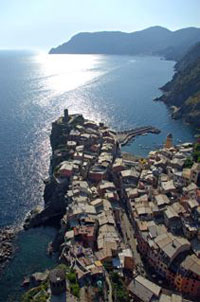

Liguria
The region of Italy which lies on the Italian Riviera, this crescent-shaped strip of land is the most famous and visited area of the Italian coastline. With its capital city of Genoa, it is sometimes referred to as il Golfo dei Poeti, or the Gulf of the Poets, Liguria beckoned such literary greats as Lord Byron and Percy Shelley, who found inspiration in its lemon groves, almond blossoms, and turquoise seas. The region’s claim to fame is undoubtedly the Cinque Terre, which translates to the Five Lands. Hidden in tiny coves along the Ligurian Riviera, five charming towns are connected by a breathtakingly scenic hiking path, and are also accessible by train or boat. In addition to the Cinque Terre, Liguria is a veritable treasure trove of hidden gems-from Portofino to the less-tourist Portovenere and Moneglia, you can be sure it will take your breath away.
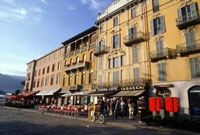

Lombardia
Lombardia is a region which offers the best of all worlds. The ultimate cosmopolitan experience, Milan offers some of the best shopping in the world. During your stay, don’t miss the church of Santa Maria della Grazie, home to Leonardo da Vinci’s Last Supper. Recently unveiled to the public after a 20-year restoration effort, the da Vinci masterpiece is in finer condition than it has been in several hundred years. Equally important are the rich culture and beauty of Bergamo and Mantova. But when you’ve had enough history for the day, escape to the tranquil beauty of Italy’s Lake Country, where clear waters touch the shores of the surrounding mountains. Lake Como is the most popular tourist destination; escape the crowds and relax at neighboring Lake Maggiore or Lake Garda. Whichever you choose, the Lake Country will surely be a welcome respite from the whirlwind that is city sightseeing.
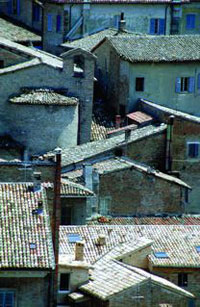

The Marches
The Marches, or le Marche in Italian, comprise a region that is one of Italy’s lesser-known wonders. Here, rolling hills separate the shores of the Adriatic from the peaks of the Apennines, traditional mountain hamlets from umbrella-crowded beaches. Urbino, an inland town easily accessible by train, is considered one of the most exquisite Renaissance towns in the world. With picturesque stone dwellings scattered along winding city streets, to turreted palaces and ancient city walls, the Marches encompass all that is classic Italy.
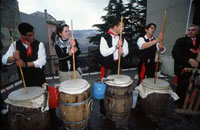

Molise
The second smallest of Italy’s regions, Molise is comparable to the size of Rhode Island and is Italy’s most carefully hidden gem. A mountainous region lying south of Abruzzo, its rugged terrain and forested slopes are dotted with castles, many of which have been excellently preserved. Here you will find charming medieval hamlets, fascinating ancient ruins and some of the most untouched nature in all of Europe.


Piedmont
Bordering France and Switzerland, Piedmont, or Piemonte as they say in Italian, has been a politically influential region for centuries. During the unification of Italy, Torino, also the capital of the region, served as the nation’s capital from 1861-1865. The region has become a renowned producer of fine food and wine, which residents argue is the best in Italy. Made famous to the world as the host of the 2006 Winter Olympic Games, the classically elegant city of Torino has finally received the attention it deserves.
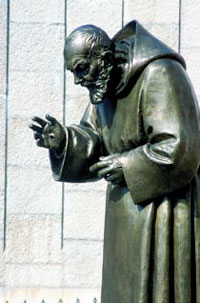

Puglia
This little-known but fascinating region, the heel of the Italian “boot,” is a trove of treasures just waiting to be discovered. Its whitewashed trulli, peculiar, beehive-like structures, are arguably the most fascinating attraction of the region. Whitewashed cones made of stones held together without mortar, they are visible in almost every wheat field and olive grove. In Puglia, fresh seafood and prized olive oils make for exquisite dietary staples. An enchanting land, full of mystery and charm, Puglia is the perfect region for anyone who needs an escape from the maddening crowds of Italy’s heavily tourist areas.
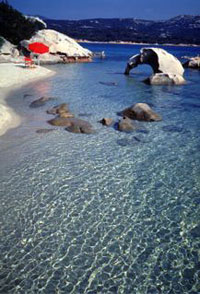

Sardinia
Lying 120 miles west of the Italian peninsula, Sardinia is home to what is arguably Europe’s most spectacular coastline. The famed Costa Smeralda, the Emerald Coast, is a 34-mile stretch of rugged terrain which has been converted into a five-star beach resort. Frequented by the rich and famous, Sardinia, particularly the Costa Smeralda, is considered one of the world’s most glamorous locales. Also worth noting is the lovely Alghero, where palm-filled parks and twisting medieval streets cast a spell. Here a dialect is spoken that bears a strong resemblance to Catalan, a striking reminder of the long past days of Spanish rule. Just a few kilometers from Alghero is Capo Caccia, renowned for its underground labyrinth of ancient caves. A captivating land of mystery and wonder, rich in beauty and history, Sardinia is sure to leave a lasting impression.
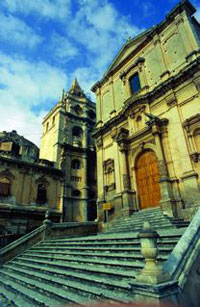

Sicily
Sicily is a paradox. At once a land of golden sunshine and sinister shadows, this long-talked about region is known to most as the notorious home of The Godfather. Yet there is so much more to Sicily than the shadow of organized crime, and it eagerly awaits you. With the sweet perfume of almond blossoms hanging in the air, you’ll feel like you’ve traveled through time to the 5th century B.C. as you explore the ancient Greek and Roman ruins. An enchanting land where Archimedes taught and Saint Paul preached, Sicily was once a Greek colony, a Roman province, an Arab emirate, and a Norman kingdom. Each of these different cultures made Sicily their own, leaving an eclectic history whose presence is still felt today. A truly unique island where art, archeology, history, and folklore come alive, Sicily is almost a nation unto itself.
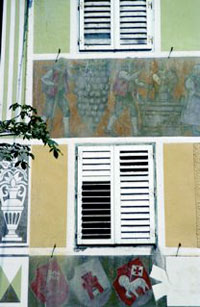

Trentino Alto Adige
Perhaps the least known of Italian regions, Trentino Alto Adige is possibly Italy’s best kept secret. Here magnificent scenery, snow-capped mountaintops, alpine meadows and charming medieval towns make up the landscape. In winter, the skiing is unparalleled, and Trentino Alto Adige is home to a multitude of inviting ski resorts. Lying on the country’s northeastern border with Austria, the region is full of mountain hamlets where German is the most common language and bratwurst is more common than spaghetti. In fact, you’ll find that most localities have two names, both Italian and German. In this hidden gem of a region, you’ll find the blending of two distinct cultures to create a truly memorable trip.
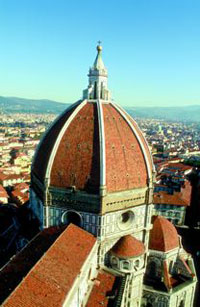

Tuscany
Tuscany, fields of sunflowers, Chianti wine, Florence, the art city of Italy, vineyards and olive oil. This region has inspired countless artists, poets, and dreamers alike with its rolling hills and lush vineyards. Its charming towns and their cobblestone streets beckon visitors and beg them to slow down their frantic pace, sip a glass of chianti, and relax in fields of brilliant sunflowers. The jewel of Tuscany is, of course, Firenze, or Florence. Here the sun sets over a sea of burnt orange roofs and towering domes. Once the undisputed European capital of art, architecture, commerce, and political thought, Florence was home to such legendary figures as Galileo, Machiavelli, Dante, and Michelangelo. Today, a tourist’s paradise, it still retains its old-world charm and culture that made it famous more than half a century ago. Yet whether you prefer the bustle of the city or the peace found in the rolling hills of the countryside, Tuscany is surely a perfect destination for every traveler.
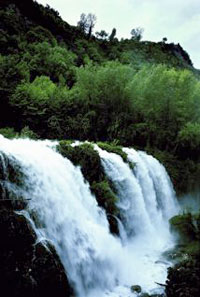

Umbria
Sometimes referred to as the “Green Heart of Italy,” Umbria is a region rich in natural beauty, where hills and mountains cast shadows over lush chestnut groves and elm forests. This landlocked region’s overwhelmingly medieval character echoes of the mysticism and mysteries of the Dark Ages. The region’s identity has been largely influenced by Christianity, and it is here that St. Francis of Assisi shamed the extravagant Catholic church with his humility. In fact, the church which bears his name, the Basilica di San Francesco, is widely renowned as the treasure of Assisi. And just 25 minutes away lies the charming Perugia, which at once possesses all the allure of a small town and the vitality of a major city. And perhaps the biggest attraction of all, it is home to the world’s best chocolate~ the baci or chocolate kiss in Italian!
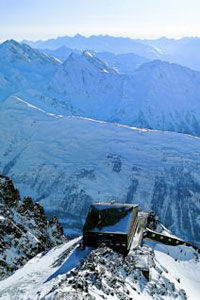

Valle d’Aosta
Italy’s smallest region, Valle D’Aosta is an adventure lover’s paradise. It is here that you will find Courmayeur, one of Europe’s popular ski resorts, nestled at the base of Monte Bianco (the Italian side of Mont Blanc). The cable car ride that carries adventuresome travelers over the peak of Mont Blanc into Chamonix, France is aptly named “Riding the Glaciers,” and is truly the most breathtaking of its kind. Yet, while most tourists flock to this tiny region for the thrill of its extreme sports, Valle D’Aosta is a treasure trove of unique art and architecture just begging to be discovered, unbeknownst to most travelers. Here Gothic is omnipresent, showing its face in numerous churches, castles, and cathedrals. Of course there are relics from the Romans, and examples of Baroque art, but what is unique to this region is that the Gothic style prevailed until the 17th century, basically eclipsing the Renaissance. By all means, come to Valle D’Aosta for the adventure of a lifetime, but don’t leave without exploring some of the art and architecture that sets this region apart from the rest.
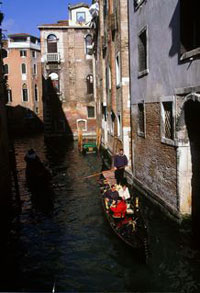

Veneto
From the jagged peaks of the Dolomites to the fertile banks of the Po River, the Veneto region has a geography as diverse as its history. Its crowing glory is, of course, Venice, the mystical city which seems more like a scene from a storybook than a bustling metropolis. In its labyrinth of narrow, crooked streets, the endless beauty of its canals and bridges, charming cafes and shops, you can’t help feeling like you’ve been transported to another world. Yet Venice is not the only spectacular destination in this region. Venturing just 70 miles east of Venice you will stumble upon “fair Verona.” Suspend all disbelief and loose yourself in the romance of Romeo and Juliet in this charming city that is determined to keep the famous love story alive. City officials have even gone so far as to designate a 14th century palazzo-complete with Juliet’s balcony-as the famed residence of the Capulets. A visit to Verona wouldn’t be complete without a night of opera at the city’s magnificently preserved Roman amphitheater, which dates back 2,000 years. For travelers seeking looking for romance, the Veneto region surely stands above the rest.










